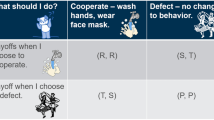Abstract
Recent work has found that the behavior of an individual can be altered when infected by a parasite. Here we explore the question: under what conditions, in principle, can a general parasitic infection control system-wide social behaviors? We analyze fixed points and hysteresis effects under the Master Equation, with transitions between two behaviors given two different subpopulations, healthy vs. parasitically-infected, within a population which is kept fixed overall. The key model choices are: (i) the internal opinion of infected humans may differ from that of the healthy population, (ii) the extent that interaction drives behavioral changes may also differ, and (iii) indirect interactions are most important. We find that the socioconfiguration can be controlled by the parasitically-infected population, under some conditions, even if the healthy population is the majority and of opposite opinion.






Similar content being viewed by others
References
Arfken, G.B., Weber, H.J.: Mathematical Methods for Physicists, 6th edn. Elsevier, London (2005)
Ben-Naim, E., Redner, S.: Dynamics of social diversity. J. Stat. Mech. Theory Exp. 2005(11), L11002 (2005). https://doi.org/10.1088/1742-5468/2005/11/L11002
Castellano, C., Fortunato, S., Loreto, V.: Statistical physics of social dynamics. Rev. Mod. Phys. 81, 591 (2009). https://doi.org/10.1103/RevModPhys.81.591
Ferm, L., Lötstedt, P., Hellander, A.: A hierarchy of approximations of the master equation scaled by a size parameter. J. Sci. Comput. 34, 127–151 (2008). https://doi.org/10.1007/s10915-007-9179-z
Flache, A., Mäs, M.: How to get the timing right. A computational model of the effects of the timing of contacts on team cohesion in demographically diverse teams. Comput. Math. Org. Theory 14, 23–51 (2008). https://doi.org/10.1007/s10588-008-9019-1
Flegr, J.: Effects of Toxoplasma on human behavior. Schizophr. Bull. 33(757–760), 3 (2007). https://doi.org/10.1093/schbul/sbl074
Flegr, J., Havlíc̆ek, J., Kodym, P., Malý, M., Smahel, Z.: Increased risk of traffic accidents in subjects with latent toxoplasmosis: a retrospective case-control study. BMC Infect. Dis. 2(11), 11 (2002). https://doi.org/10.1186/1471-2334-2-11
Fu, G., Zhang, W., Li, Z.: Opinion dynamics of modified Hegselmann-Krause model in a group-based population with heterogeneous bounded confidence. Physica A 419, 558–565 (2015). https://doi.org/10.1016/j.physa.2014.10.045
Gaisbauer, F., Olbrich, E., Banisch, S.: The dynamics of opinion expression. arXiv:1912.12631 (2019)
Gardiner, C.W.: Handbook of Stochastic Methods, 2nd edn. Springer, New York (1985)
Haken, H.: Advanced Synergetics. Springer, Berlin (1983)
Haken, H.: Synergetics, 3rd edn. Springer, Berlin (1983)
Helbing, D.: Quantitative Sociodynamics: Stochastic Methods and Models of Social Interaction Processes, 2nd edn. Springer, Berlin (2010)
Hrdá, Š., Votýpka, J., Kodym, P., Flegr, J.: Transient nature of Toxoplasma gondii-induced behavioral changes in mice. J. Parasitol. 86(657–663), 4 (2000). https://doi.org/10.1645/0022-3395(2000)086[0657:TNOTGI]2.0.CO;2
Johnson, S.K., Fitza, M.A., Lerner, D.A., Calhoun, D.M., Beldon, M.A., Chan, E.T., Johnson, P.T.J.: Risky business: linking Toxoplasma gondii infection and entrepreneurship behaviours across individuals and countries. Proc. R. Soc. B 285(1883), 20180822 (2018). https://doi.org/10.1098/rspb.2018.0822
Kardar, M.: Statistical Physics of Fields. Cambridge University Press, Cambridge (2007)
Lafferty, K.D.: Can the common brain parasite, Toxoplasma gondii, influence human culture? Proc. R. Soc. B 273(2749–2755), 1602 (2006). https://doi.org/10.1098/rspb.2006.3641
Lindová, J., Novotná, M., Havlíček, J., Jozífková, E., Skallová, A., Kolbeková, P., Hodný, Z., Kodym, P., Flegr, J.: Gender differences in behavioural changes induced by latent toxoplasmosis. Int. J. Parasitol. 36(1485–1492), 14 (2006). https://doi.org/10.1016/j.ijpara.2006.07.008
Lindová, J., Příplatová, L., Flegr, J.: Higher extraversion and lower conscientiousness in humans infected with toxoplasma. Eur. J. Pers. 26, 285–291 (2011). https://doi.org/10.1002/per.838
Macy, M.W., Willer, R.: From factors to actors: computational sociology and agent-based modeling. Annu. Rev. Sociol. 28(1), 143–166 (2002). https://doi.org/10.1146/annurev.soc.28.110601.141117
McAuliffe, K.: This is Your Brain on Parasites: How Tiny Creatures Manipulate Our Behavior and Shape Society. Eamon Dolan/Houghton Mifflin Harcourt, London (2016)
Moore, J.: Parasites and the Behavior of Animals, Ecology and Evolution. Oxford Univeristy Press, Oxford (2002)
Noelle-Neumann, E.: The spiral of silence a theory of public opinion. J. Commun. 24(2), 43–51 (1974). https://doi.org/10.1111/j.1460-2466.1974.tb00367.x
Noelle-Neumann, E., Petersen, T.: The spiral of silence and the social nature of man. In: Kaid, L.L. (ed.) Handbook of Political Communication Research, pp. 357–374. Routledge, London (2004)
Reiber, C., Shattuck, E.C., Fiore, S., Alperin, P., Davis, V., Moore, J.: Change in human social behavior in response to a common vaccine. Ann. Epidemiol. 20(729–733), 10 (2010). https://doi.org/10.1016/j.annepidem.2010.06.014
Schweitzer, F., Bartels, J., Pohlmann, L.: Simulation of opinion structures in social systems. In: Ebeling, W., Peschel, M., Weidlich, W. (eds.) Models of Selforganization in Complex Systems : MOSES, Mathematical Research. Akademie Verlag, Berlin (1991)
Strogatz, S.H.: Nonlinear Dynamics and Chaos. Westview Press, Boulder (1994)
Tenter, A.M., Heckeroth, A.R., Weissb, L.M.: Toxoplasma gondii: from animals to humans. Int. J. Parasitol. 30(1217–1258), 12–13 (2000). https://doi.org/10.1016/S0020-7519(00)00124-7
Weidlich, W.: The statistical description of polarization phenomena in society. Br. J. Math. Stat. Psychol. 24(2), 251 (1971). https://doi.org/10.1111/j.2044-8317.1971.tb00470.x
Weidlich, W.: The use of statistical models in sociology. Collect. Phenom. 1(1), 51 (1972)
Weidlich, W.: Quantitative social science. Phys. Scr. 35(3), 380 (1987). https://doi.org/10.1088/0031-8949/35/3/025
Weidlich, W.: Physics and social science—the approach of synergetics. Phys. Rep. 204(1), 1 (1991). https://doi.org/10.1016/0370-1573(91)90024-G
Weidlich, W., Haag, G.: Concepts and Models of a Quantitative Sociology: The Dynamics of Interacting Populations, 1st edn. Springer, Berlin (1982)
Weidlich, W., Haag, G. (eds.): Interregional Migration: Dynamic Theory and Comparative Analysis. Springer, Berlin (1988)
Yereli, K., Balcioğlu, I.C., Özbilgin, A.: Is Toxoplasma gondii a potential risk for traffic accidents in turkey? Forensic Sci. Int. 163(34–37), 1–2 (2006). https://doi.org/10.1016/j.forsciint.2005.11.002
Zimmer, C.: Parasite Rex: Inside the Bizarre World of Nature’s Most Dangerous Creatures. Atria, London (2001)
Author information
Authors and Affiliations
Corresponding author
Additional information
Communicated by Irene Giardina.
Publisher's Note
Springer Nature remains neutral with regard to jurisdictional claims in published maps and institutional affiliations.
Rights and permissions
About this article
Cite this article
Phillips, M. Hysteresis Effects in Social Behavior with Parasitic Infection. J Stat Phys 181, 293–304 (2020). https://doi.org/10.1007/s10955-020-02580-6
Received:
Accepted:
Published:
Issue Date:
DOI: https://doi.org/10.1007/s10955-020-02580-6




